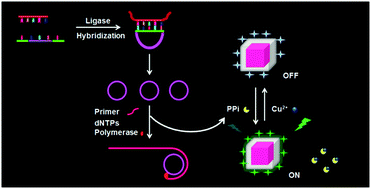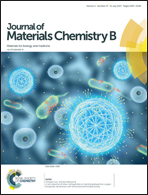Core–shell gold nanocubes for point mutation detection based on plasmon-enhanced fluorescence†
Abstract
Point mutation, with a permanent change in nucleic acid sequences, can affect the expression of genetic information forming the basis for numerous human genetic diseases, which makes its detection crucially important. Here, we reported a simple and sensitive method for point mutation detection, which employs a core–shell gold nanocube (Au NC) based on plasmon-enhanced fluorescence (PEF). For the generation of PEF, a Au NC was chosen as a core and silica as a spacer layer to adjust the distance between the Au NC and the dye of 5-carboxyfluorescein. Cu2+ quenched fluorescence by the interaction with the dye, while a “turn-on” signal was observed with the presence of pyrophosphate (PPi) owing to the strong affinity between Cu2+ and PPi, which subsequently achieved sensitive and selective detection of PPi. The experiment and theoretical simulations indicated that the enhanced signal was generated from square scattering cross sections and multiple corners, which could also be applied to cell imaging. Moreover, the rolling circle amplification coupled with ligase chain reaction (L-RCA) assay was also performed, which generated a circular DNA to initiate the RCA reaction accompanied by the generation of PPi that can be detected by the PEF sensor. Therefore, point mutation (C to T) can be detected based on fluorescence changes with a detection limit of 1.3 pM. This is a specific, simple, and economical method for point mutation detection, which overcomes the shortcomings of traditional detections of RCA products and point mutation.



 Please wait while we load your content...
Please wait while we load your content...